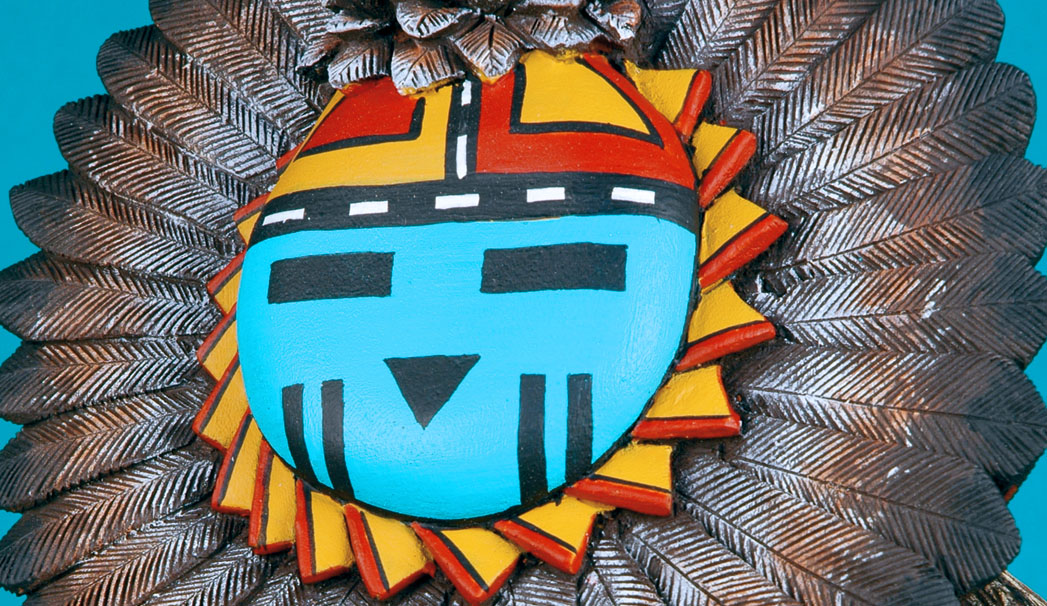The word “kachina” comes up often in the Southwest, commonly understood to refer to small dolls created by Native American artists from cottonwood root. They make for popular gifts, but many visitors are unaware of their real significance in Native American culture. The dolls, as associated with the Hopi people (the Zuni also carve dolls for religious ceremonies), are called tithu – they represent katsinam, spirit beings that visit the Hopi mesas in northern Arizona in the form of clouds from the winter to the summer solstices. There are several hundred katsinam (in the singular, each is a katsina) representing plants, animals, insects, and human qualities. There are clown katsinam that entertain, and demons that frighten children into behaving (our personal favorites); most are messengers between the Hopi and the gods. At private Hopi ceremonies and dances performed for katsinam, infants, young girls, and women receive katsina dolls.
Newly arriving settlers in the southwest mispronounced katsinam, turning it into kachina. In modern Hopi culture, the dolls are referred to as katsina. To learn more, we met with two award-winning Hopi katsina carvers. Gerry Quotskuyva carves dolls in a contemporary style. Kevin Sekakuku carves traditional and contemporary katsina – when we spoke, he was still aglow after winning three ribbons at the 2007 Santa Fe Indian Market. We also spoke with the three women who own Kachina House in West Sedona, who share insights into the business of buying, selling, and collecting katsina.
Gerry Quotskuyva
“I was born Hopi so I was born with a paintbrush in my hand – it’s our cultural responsibility to create products used in ceremonies,” says Gerry Quotskuyva, seated at his kitchen table in his adobe-style home in Rimrock, three of his brightly painted katsina dolls displayed in front of him. “When you live on the reservation your influence comes from your religion but when you grow up off the reservation, like I did, you have more individuality. I wanted to create something I could showcase.”
Born in Winslow and raised in Flagstaff, Gerry didn’t begin carving katsinas until he was in his mid-30s – prior to becoming an artist he says he was a “professional student” and worked as a caterer for a Los Angeles company (he worked on the sets of John Landis’ ¡Three Amigos! and Clint Eastwood’s Heartbreak Ridge in the mid-1980s). At a time when he was short on cash he began crafting medicine wheels and shields for Stuckey’s, a chain of roadside stops with gift stores. At one point he was creating 2,100 units per month, so with his income from Stuckey’s as a cushion, he opened a shop in Old Town Cottonwood. As fate would have it, shortly after opening GQ’s in the early 1990s, Gerry lost the Stuckey’s account. But he noticed an interesting trend at the store: Several customers asked him for katsina dolls. One day he found a pocket knife in his truck, picked up a piece of cottonwood root, and carved three dolls after he dreamed of katsinas flying from ears of corn, the corn husks turning into their robes. One of those first three dolls, Corn Maiden, is currently in the hands of a Sedona business owner.
Gerry closed the Cottonwood shop and focused on his carving, selling the dolls at regional Indian markets and to galleries in Sedona, Prescott, and Flagstaff. Gerry’s katsinas, both his full-figure dolls and sculptures, are in a contemporary style – he uses bright-color acrylic paints and a wood-burning technique for texture in hair and on jewelry. Some of his dolls are carved from one piece of cottonwood root while others come from several pieces. (For years, collectors insisted dolls be carved from one root but Gerry says there’s no historical significance to one-piece dolls in the Hopi culture – nails can be seen in old dolls on display in museums.) All katsinas represent cloud deities and Gerry’s dolls wear capes and robes that bell out at the bottom, representative of the evaporative process. Their capes are all open on one side to release the spirit or heart of the piece. The forward foot, visible hand, and broad shoulders are the embodiment of the soul. Gerry tends to stick with more common katsinas such as Crow Mother, Sunface, and various ogres. He says some of his dolls, including Corn Maiden and Butterfly Maiden, are more like artistic interpretations of katsinas.
“A lot of people weren’t sure about my work,” he says. “It was so different. I didn’t step over the line but I came close to the edge. But I took my first Corn Maiden to my grandfather for approval and he loved it.”




